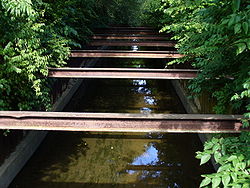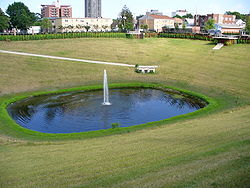
Boneyard Creek
Encyclopedia
Boneyard Creek is a 3.3 miles (5.3 km) waterway that drains much of the cities of Champaign
and Urbana, Illinois
. It is a tributary of the Saline Branch of the Salt Fork Vermilion River
, which is a tributary of the south-flowing Vermilion River
and the Wabash River
. The creek flows through the northern sections of the campus of the University of Illinois at Urbana-Champaign
. The newsletter of the university's ACM
chapter is Banks of the Boneyard, named after the creek.
In pre-settlement times, the Boneyard, like most of the other watercourses of Champaign County, Illinois
, was probably a series of connected wetlands without a clearly defined channel. With settlement, the drainage was "improved". Today the Boneyard is a highly channelized stream, running in a slit trench, with steel sheet pilings along much of its length.
 There are several stories about the origin of the name "Boneyard". One is that the local Indians hung their dead over the stream, allowing the bones to fall into the creek, so that the creek was full of human bones when the first American settlers arrived. This could be an example of excarnation
There are several stories about the origin of the name "Boneyard". One is that the local Indians hung their dead over the stream, allowing the bones to fall into the creek, so that the creek was full of human bones when the first American settlers arrived. This could be an example of excarnation
, which many Native American peoples indeed practiced. One problem with this story is that there have been no confirmed findings of human bones in excavations along the streams. In University of Illinois lore, the name "Boneyard" comes from the remains of poor students who couldn't hack it in the school's tough engineering curriculum.
Prior to the environmental movement in the late 1960s the Boneyard was an open sewer, with floating solids and a foul stench. During the 1970s many sources of pollution were removed, and water quality gradually improved.
 The Urbana-Champaign Sanitary District sewage outfall is located on the Saline Branch, just downstream from where the Boneyard enters that stream. Late in the 1970s, sewage chlorination, required by environmental regulations, was identified as a major negative factor for aquatic life. Although disinfection theoretically reduced the chances of hypothetical bathers contracting disease downstream of a sewage outfall, chlorination also killed most aquatic life for miles downstream. Late in the 1980s, the Sanitary District was allowed to discontinue chlorination. Fish soon returned to the Boneyard, after the chlorine block was removed from the Saline Branch. The fish, however, live a tenuous life on the Boneyard, which has frequently seen major fish kill
The Urbana-Champaign Sanitary District sewage outfall is located on the Saline Branch, just downstream from where the Boneyard enters that stream. Late in the 1970s, sewage chlorination, required by environmental regulations, was identified as a major negative factor for aquatic life. Although disinfection theoretically reduced the chances of hypothetical bathers contracting disease downstream of a sewage outfall, chlorination also killed most aquatic life for miles downstream. Late in the 1980s, the Sanitary District was allowed to discontinue chlorination. Fish soon returned to the Boneyard, after the chlorine block was removed from the Saline Branch. The fish, however, live a tenuous life on the Boneyard, which has frequently seen major fish kill
s as a result of spills and other accidents in the urbanized area.
One branch of the Boneyard extends into South Neil Street, where it meets the headwaters of the Embarras
and Kaskaskia
rivers. During the 1920s, the Illinois Central Railroad
tracks were elevated in this area, to allow traffic to pass under the tracks. The rail embankment cut off the South Neil branch of the Boneyard, creating "Lake Neil" after a moderate rain event. This flooding would subside over several hours as the water flowed under the rail embankment through tiles.
 During the 1980s, "Lake Neil" was eliminated by placing larger tiles under the rail embankment. This, however, had the effect of creating flooding on the other side of the tracks, near Fourth and Green, where the branches of the Boneyard joined. In wet years, flooding caused damage estimated to be as much as $1000 per year.
During the 1980s, "Lake Neil" was eliminated by placing larger tiles under the rail embankment. This, however, had the effect of creating flooding on the other side of the tracks, near Fourth and Green, where the branches of the Boneyard joined. In wet years, flooding caused damage estimated to be as much as $1000 per year.
During the late 1990s, the City of Champaign resolved to eliminate the flooding near Fourth Street and Green Street. After considerable debate, the city built an enormous detention basin upstream of Fourth and Green streets, at a cost of approximately $22 million. The basin is designed to fill when the Boneyard approaches flood stage, preventing flooding at Fourth and Green streets up to a 100-year flood
.
Champaign, Illinois
Champaign is a city in Champaign County, Illinois, in the United States. The city is located south of Chicago, west of Indianapolis, Indiana, and 178 miles northeast of St. Louis, Missouri. Though surrounded by farm communities, Champaign is notable for sharing the campus of the University of...
and Urbana, Illinois
Urbana, Illinois
Urbana is the county seat of Champaign County, Illinois, United States. As of the 2010 census, the population was 41,250. Urbana is the tenth-most populous city in Illinois outside of the Chicago metropolitan area....
. It is a tributary of the Saline Branch of the Salt Fork Vermilion River
Salt Fork Vermilion River
The Salt Fork is a tributary of the Vermilion River located in Illinois.The Salt Fork owes its name to saline springs that provided natural salt licks for animals, and which were used for production of salt by Native Americans and early settlers. The springs were located about eight miles west of...
, which is a tributary of the south-flowing Vermilion River
Vermilion River (Wabash River tributary)
The Vermilion River is a tributary of the Wabash River in the states of Illinois and Indiana, United States.There are two "Vermilion Rivers" in Illinois. The Wabash tributary flows south, while the other Vermilion River flows north to the Illinois River...
and the Wabash River
Wabash River
The Wabash River is a river in the Midwestern United States that flows southwest from northwest Ohio near Fort Recovery across northern Indiana to southern Illinois, where it forms the Illinois-Indiana border before draining into the Ohio River, of which it is the largest northern tributary...
. The creek flows through the northern sections of the campus of the University of Illinois at Urbana-Champaign
University of Illinois at Urbana-Champaign
The University of Illinois at Urbana–Champaign is a large public research-intensive university in the state of Illinois, United States. It is the flagship campus of the University of Illinois system...
. The newsletter of the university's ACM
Association for Computing Machinery
The Association for Computing Machinery is a learned society for computing. It was founded in 1947 as the world's first scientific and educational computing society. Its membership is more than 92,000 as of 2009...
chapter is Banks of the Boneyard, named after the creek.
In pre-settlement times, the Boneyard, like most of the other watercourses of Champaign County, Illinois
Champaign County, Illinois
Champaign County is a county located in the U.S. state of Illinois. According to the 2010 census, it has a population of 201,081, which is an increase of 11.9% from 179,669 in 2000.. It is the 10th most populous county in Illinois...
, was probably a series of connected wetlands without a clearly defined channel. With settlement, the drainage was "improved". Today the Boneyard is a highly channelized stream, running in a slit trench, with steel sheet pilings along much of its length.

Excarnation
In archaeology and anthropology, the term, excarnation , refers to the burial practice of removing the flesh and organs of the dead, leaving only the bones....
, which many Native American peoples indeed practiced. One problem with this story is that there have been no confirmed findings of human bones in excavations along the streams. In University of Illinois lore, the name "Boneyard" comes from the remains of poor students who couldn't hack it in the school's tough engineering curriculum.
Prior to the environmental movement in the late 1960s the Boneyard was an open sewer, with floating solids and a foul stench. During the 1970s many sources of pollution were removed, and water quality gradually improved.

Fish kill
The term fish kill, known also as fish die-off and as fish mortality, is a localized die-off of fish populations which may also be associated with more generalised mortality of aquatic life...
s as a result of spills and other accidents in the urbanized area.
One branch of the Boneyard extends into South Neil Street, where it meets the headwaters of the Embarras
Embarras River
The Embarras River is a tributary of the Wabash River in southeastern Illinois in the United States. The waters of the Embarras reach the Gulf of Mexico via the Wabash, Ohio, and Mississippi rivers. The river drains a watershed of approximately in an agricultural region...
and Kaskaskia
Kaskaskia River
The Kaskaskia River is a tributary of the Mississippi River, approximately long, in central and southern Illinois in the United States. The second largest river system within Illinois, it drains a rural area of farms, as well as rolling hills along river bottoms of hardwood forests in its lower...
rivers. During the 1920s, the Illinois Central Railroad
Illinois Central Railroad
The Illinois Central Railroad , sometimes called the Main Line of Mid-America, is a railroad in the central United States, with its primary routes connecting Chicago, Illinois with New Orleans, Louisiana and Birmingham, Alabama. A line also connected Chicago with Sioux City, Iowa...
tracks were elevated in this area, to allow traffic to pass under the tracks. The rail embankment cut off the South Neil branch of the Boneyard, creating "Lake Neil" after a moderate rain event. This flooding would subside over several hours as the water flowed under the rail embankment through tiles.

During the late 1990s, the City of Champaign resolved to eliminate the flooding near Fourth Street and Green Street. After considerable debate, the city built an enormous detention basin upstream of Fourth and Green streets, at a cost of approximately $22 million. The basin is designed to fill when the Boneyard approaches flood stage, preventing flooding at Fourth and Green streets up to a 100-year flood
100-year flood
A one-hundred-year flood is calculated to be the level of flood water expected to be equaled or exceeded every 100 years on average. The 100-year flood is more accurately referred to as the 1% annual exceedance probability flood, since it is a flood that has a 1% chance of being equaled or exceeded...
.

